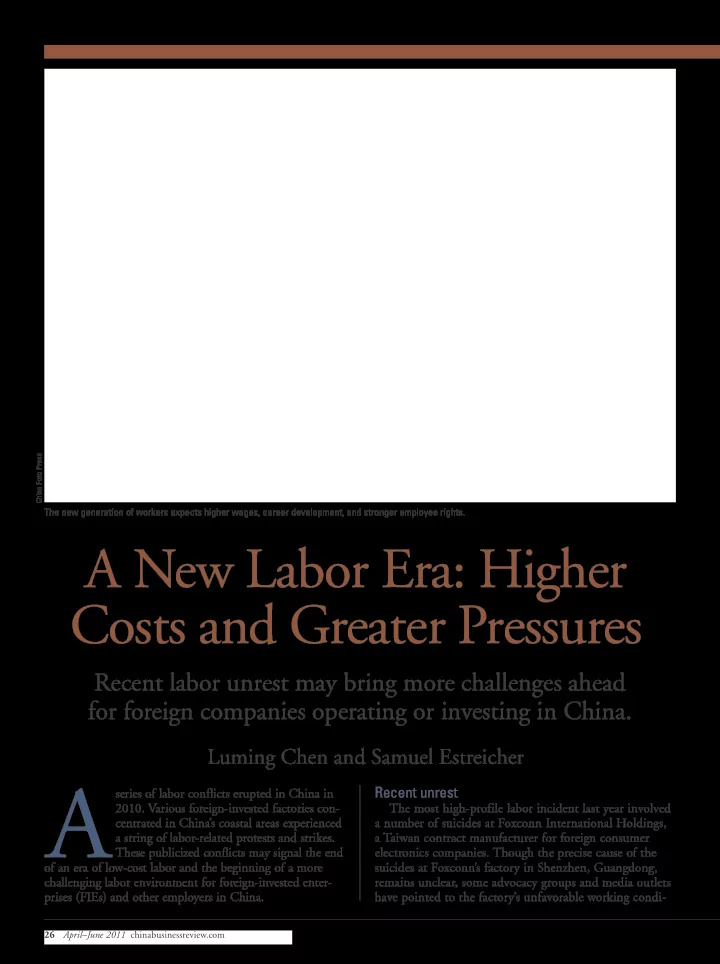

China Foto Press The new generation of workers expects higher wages, career development, and stronger employee rights. A New Labor Era: Higher Costs and Greater Pressures Recent labor unrest may bring more challenges ahead for foreign companies operating or investing in China. Luming Chen and Samuel Estreicher A Recent unrest series of labor conflicts erupted in China in 2010. Various foreign-invested factories con- The most high-profile labor incident last year involved centrated in China’s coastal areas experienced a number of suicides at Foxconn International Holdings, a string of labor-related protests and strikes. a Taiwan contract manufacturer for foreign consumer These publicized conflicts may signal the end electronics companies. Though the precise cause of the of an era of low-cost labor and the beginning of a more suicides at Foxconn’s factory in Shenzhen, Guangdong, challenging labor environment for foreign-invested enter- remains unclear, some advocacy groups and media outlets prises (FIEs) and other employers in China. have pointed to the factory’s unfavorable working condi- 26 April–June 2011 chinabusinessreview.com
FOCUS: HUMAN RESOURCES tions and, above all, low wages. In response to public crit- High cost of living icism and local government pressure, Foxconn raised basic The high cost of living in China’s coastal regions is also monthly salaries for its production workers from ¥900 fueling demands for higher wages. In 2007 and 2008, ($137) to ¥2,000 ($305). The Shenzhen municipal gov- China’s consumer price index rose by 4.8 percent and 5.9 ernment subsequently increased the city’s minimum percent, respectively—well exceeding the official annual monthly wages to ¥1,100 ($168), an average increase of targets. Though cost of living in cities such as Shenzhen 15.8 percent. In April 2011, Shenzhen raised its mini- rose significantly in the last decade, some profitable compa- mum wage again to ¥1,320 ($201). In late June 2010, nies have not increased wages to reflect higher prices, spur- Foxconn declared it would outsource the management of ring worker dissatisfaction. its worker dormitories and relocate some facilities to Several companies involved in the May 2010 strikes Taiwan and China’s inland regions, where monthly mini- were paying the minimum wages required by local law. mum wages can be as low as ¥600 ($91) to ¥800 ($122). The wage complaints may have reflected the fact that In March 2011, the company further Japanese- and Taiwan-owned factories announced that it would move 200,000 often paid lower wages than comparably Quick Glance jobs to inland provinces with lower costs. sized German-owned facilities and other In addition to the Foxconn develop- ■ Worker shortages, higher cost FIEs, sometimes in the same area. ments, a string of strikes broke out in May of living, and greater employee 2010 at several other factories in Greater “rights-consciousness” of workers attention to workplace rights have Guangdong and China’s coastal regions. The new generation of Chinese blue- caused rising labor unrest in The most publicized strikes occurred at collar workers, born during the 1980s and China. Honda Motor Co. factories in several ■ The PRC government is issuing 1990s, are more sensitive to social issues Guangdong cities. In late May, Honda and workplace rights than their parents. more labor regulations and workers in Foshan walked out, demanding Previous generations might have taken any promoting state-led unionization higher wages and better working condi- city job available, even for low salaries. But and collective bargaining in tions. Honda responded with a 24 percent young workers today seek jobs that not foreign companies. general pay increase. The Foshan strike ■ As China’s labor environment only pay well enough to secure a better life then triggered work stoppages at several for their families, but also provide career becomes more challenging, other facilities in Guangdong: a Honda development, treat employees with respect, companies should periodically lock systems supplier, one of Honda’s gear- and help them gain a foothold in the cities review their employment policies shift suppliers, and Honda’s affiliate Nihon (see p.20). Furthermore, despite state over- and wages and consider whether Plast Co., Ltd. Because of repercussions sight, Internet access has helped workers they wish to move operations from the labor unrest, Honda’s sales in learn quickly about strikes, wages, and westward to lower costs. China fell 2.7 percent in June, lagging working conditions at other companies. behind China’s overall auto industry sales, Government interest in labor market regulation which increased 23.5 percent from a year earlier. In the early decades of the reform era, the PRC govern- Sources of labor unrest ment primarily focused on economic growth—starting with Though not widely reported by the Chinese media, coastal regions, which rose ahead of rural areas. Since 2003, observers believe that strikes in China extend beyond the however, the government has begun to shift its focus to well-publicized incidents at Foxconn and Honda. Several include social harmony, political stability, and better factors suggest that labor unrest may become an increasingly income distribution. The new minimum wage law issued in significant aspect of the Chinese manufacturing industry. 2004 and the much-touted 2007 Labor Contract Law, which enhances statutory rights for employees and imposes Tight labor market greater obligations on employers, reflect this shift in focus. The tight labor market in China’s coastal regions is a The government’s tolerance of sustained, extensive media critical element of the recent labor unrest. China’s labor coverage of the suicides and strikes at several FIEs may also shortages first appeared in Guangdong in 2003 and have reflect this new thinking. It remains unclear, however, since appeared in other major industrial regions, including whether the new approach will extend to wholly and par- the Yangzi River Delta around Shanghai. The shortages tially state-owned enterprises. are in part because of the PRC government’s one-child The PRC government is also formulating more labor policy and the household registration ( hukou ) system, contract regulations to protect worker rights. In September which discourages the rural population from moving to 2010, the PRC Supreme People’s Court issued Interpre- the cities. tations on Several Issues Concerning the Application of chinabusinessreview.com April–June 2011 27
Recommend
More recommend